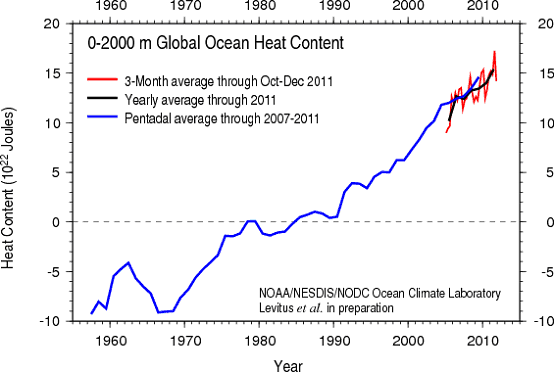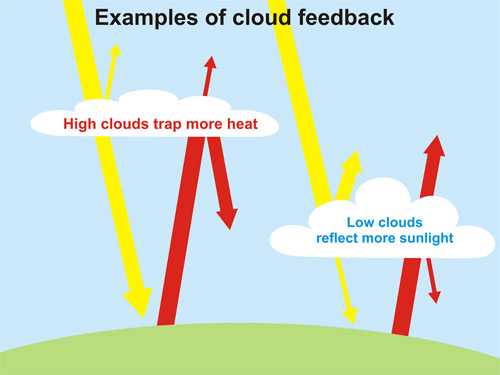Breaking News...The Earth is Warming... Still. A LOT
Posted on 16 March 2012 by Glenn Tamblyn
In a previous post we discussed how the argument that the Earth has stopped warming doesn't make much sense because the people claiming this don't know how to draw their 'system boundaries' correctly - how can you work out whether the Earth is warming if you don't take account of all the places where it may be warming? And most commentary seems to only focus on surface temperatures. Which is only 3% of the Total Heat Content change.
So in this follow-on we would like to try and convey this warming from all the parts of the climate system in terms that we can all grasp. Grasp at an imaginative and visceral level. Because numbers, no matter how accurate, can be rather dry and hard to digest.
Do the math, Follow the heat....
Previously we showed the following diagram from the IPCC's 2007 AR4 report, highlighting the warming of the atmosphere and how small it was compared to the total warming.

Now we would like to focus on the total figure at the bottom and try to convert that into numbers that we can all get our heads around. To try and make numbers with lots of zeroes meaningful.
The total heat accumulation in the environment from 1961 to 2003 is estimated as 15.9 x 1022 Joules. Got that? Is that clear in your head? Now read on...
Next, this graph from the National Oceanographic Data Centre, looking at Ocean Heat Content in the upper half of the ocean shows the following:

Roughly 5 x 1022 Joules since 2003. Since the IPCC's graph above up to 2003 shows that most of the energy from global warming is in the oceans, to a first approximation, Ocean Heat Content change since then is going to be close enough to the Total Heat Content change.
So, total heat content change from 1961 to 2011 - 50 years - is approximately 21 x 1022 joules.
210000000000000000000000 joules
(a joule is 1 watt for 1 second. So a 100 watt light bulb will use 100 joules in 1 second)
A BIG number but somewhat unreal. So how much heat is this. What could it do? What is it in the real world, where we don't routinely look at numbers that big.
That is HOW Big...?
This is a rate of heating of 133 Terawatts. Or 0.261 Watts/m2
133 Terrawatts is 2 Hiroshima bombs a second. Continually since 1961.
Over 50 years it could heat around 500 trillion tonnes of water from 0 °C to 100 °C - around 870,000 Sydney Harbours.

If we now add in the heat needed to boil water dry once it has reached 100 °C and apply this to Sydney Harbour we calculate a very simple answer:
It would boil Sydney Harbour dry EVERY 12 HOURS!
 [EDIT. Mike 22 over at ClimateProgress found this cool image so I had to add it.]
[EDIT. Mike 22 over at ClimateProgress found this cool image so I had to add it.]
One of the worlds great harbours boiling dry twice a day! And this has been happening for the last 50 years.
Imagine. You get up in the morning to go walk the dog before you go to work and there is Sydney Harbour - ferries, yachts, tourists. The Bridge (Australians still sometimes still call it the Coat-Hanger) and the Opera House. When you come home from work that night the ferries and the yachts are all sitting in the mud at the bottom of the now evaporated harbour. And this has been happening twice a day since before the Beatles first started making Hits.
But why don't we notice this? Because instead of all this heating happening just in Sydney Harbour, this is spread out through out the worlds oceans. And they are huge: approximately 2,300,000,000 times the size of Sydney Harbour. So heat that boils the harbour would only warm the entire ocean by a fraction of a degree. So we don't notice it much. Not that it isn't real, just that we don't notice it.
And if this much heat had instead gone into just warming the atmosphere - you know, that thing we call Climate - it would have raised Air temperatures by around 42 °C over the last 1/2 Century! When I was in kindergarten, in 1961, a hot day at the beach was 35 °C. Imagine that it was now 77 °C
So lets investigate...
Where could this heat have come from?
Since the extra heat, mainly in the the oceans is the equivalent of warming the atmophere by 42 °C, if this heat had been extracted from the atmosphere to warm the oceans we would have seen a drop in Air temperatures of a similar scale: ≈ 40 °C or so of atmospheric cooling. I think we can agree that this hasn't happened.
Similarly, if freezing of ice & snow was supplying heat that could warm the oceans - hard to imagine what the process might be but theoretically possible so we need to consider it - this would require the freezing of around 12,500 Billion tonnes of extra ice per year. In contrast actually 500 Billion tonnes of ice is melting each year. No, that isn't the source.
Could it be Geothermal heat - heat coming from inside the Earth?
Sorry, no, that doesn't work either.
The rate of geothermal flux to the surface, for the entire Earth is around 47 Terawatts. This comes from residual heat remaining from when the Earth was first formed and heat from radioactive decay of minerals within the Earth. And it doesn't change suddenly. What is sudden? To a geologist, 100,000 years is sudden.
But this flow is only around 1/3rd of what is needed to account for the increase in heat. And since this flux has been very steady for a very long time, it can't be the source of the change in heat content. Since it has been so constant for so long, the normal geothermal energy flow must be part of the normal heat balance. Therefore to account for the increase in heat content, the global geothermal heat flux would need to have increased by a factor of 4 over the last 1/2 century - 1 normal flow and 3 extra flows.
Suggest an idea like that to any geologist and just watch for the look on their face!
And now we have run out of terrestrial heat sources that might do the job. Since Geothermal Energy is the only energy source on the planet large enough to even conceivably supply this much energy and even it is too small, that leaves only one option left.
An imbalance in the heat flows to and from Space. Nothing else fits the evidence.
Lets be very clear about this: NOTHING ELSE FITS THE EVIDENCE
Not theory, not ideology, not political views, not internal variability, not questions over surface temperature records, not fudged or not fudged data, not hockey sticks or Medieval Warm Periods, or perhaps missing 'hot-spots'.
The Earth is experiencing an energy imbalance with space!
NOTHING ELSE FITS THE EVIDENCE.
So, this imbalance could be because the Sun is getting warmer. But it's not. Over the last 1/2 century the Sun has, if anything, cooled slightly. See here, here, and here.
So what are left standing as viable explanations?
Greenhouse Gases and Clouds. Known Greenhouse Effect impacts of the GH gases, and possible changes in cloud behaviour. Exactly where most informed discussion of AGW occurs. The known impacts of GH Gases and the recognised uncertainties over cloud behaviour.
Some Cloudy thinking...
Lets look a little more closely at clouds. Clouds have both a cooling effect and a warming effect, depending on the type of cloud. See here and here. Low level clouds cause some cooling because they tend to reflect sunlight, while high level clouds cause some warming by trapping Infra-Red radiation.

However we can rule out the effect of low level clouds causing changes in reflection of sunlight as a cause. If the warming was because of this we would expect to see that Atmospheric warming would be strongest when the Sun is shining - Daytime & Summer. But its not - see here. Warming is happening just as much or more at Night-time or in Winter. In contrast the GH Effect operates 24/7. So low-level cloud changes can't be the cause. The evidence just doesn't fit.
So what we are left with are just 2 possibilities. High level clouds are increasing - relative to low level clouds, because it is the difference between their 2 effects that counts, or the GH gases are causing more of the GH effect.
Add to this that our understanding of the radiative effects of GH gases is based on masses of detailed data and is applied in many fields - Astronomy, Defence, Satellite observations of all types, Meteorology, even designing Micro-wave ovens - oh, and Climate Science.
Whereas the "It's the clouds" answer requires that certain types of clouds have become more common, but other types haven't. Without any viable mechanism to explain why.
It has been suggested that Cosmic Rays may influence cloud formation, and this is certainly a possibility although the evidence suggests the effect if it exists isn't very strong. And this theory is based on Cosmic Ray levels reaching the Earth varying over the 11 year Solar Cycle. So this can't explain continuous warming over nearly 5 Solar Cycles - there would need to be a long term trend in Cosmic Ray levels which isn't supported by the observations. And this theory predicts that the changes will occur in low-level clouds and as we discussed earlier, this sort of change is contradicted by the evidence about when the warming is happening.
So, we have a solid understanding of the effect of the GH gases, and clouds need to be doing some surprising flip-flops to be the only possible alternative explanation.
Can we totally rule out cloud flip-flops? No. But what are the odds that masses of detailed data are wrong but instead 'something else' is happening. Possible yes. But probable? Likely? No.
The number that changed the world....
All this can be deduced from one simple number - 21 x 1022 - that removes almost all other considerations from the table.
Its GH Gases or high level cloud changes. NOTHING ELSE FITS THE DATA.
When the first analyses of Ocean Heat Content calculated from old temperature data from the oceans where first published in the early 2000's, they were described as the 'Smoking Gun'. Because they were. They are the primary observational evidence for Global Warming and the human nature of it.
So think about this the next time you look at a picture of Sydney Harbour. Or any other harbour of your choice.
As it boils dry in your minds eye, ask 'Why?'. The possible answers to your question are very limited. Very limited indeed.































 Arguments
Arguments






























"The total heat accumulation in the environment from 1961 to 2003 is estimated as 15.9 x 10²² Joules. ..." "So heat that boils the harbour would only warm the entire ocean by a fraction of a degree."
Yes, and the IPCC tells us right off the bat in Chapter 5 of their AR4 report:
"The oceans are warming. Over the period 1961 to 2003, global ocean temperature has risen by 0.10°C from the surface to a depth of 700 m." Executive Summary
Not 0.09 or 0.11 but 0.10°C spread over 42 years, and expressed as 14.2 x 10²² Joules, it is very impressive. But 0.10°C isn't going to warm anything anywhere anymore than something less than 0.10°C.
[DB] Please cease looking for provocation where none is implied or intended.
Suggestion: Try asking for clarification on a remark before assuming the worst.
Please note that posting comments here at SkS is a privilege, not a right. This privilege can be rescinded if the posting individual treats adherence to the Comments Policy as optional, rather than the mandatory condition of participating in this online forum.
Please take the time to review the policy and ensure future comments are in full compliance with it. Thanks for your understanding and compliance in this matter.
Inflammatory rhetoric snipped.
[DB] Your claim is fully addressed on the It’s waste heat and on the interminable Waste heat vs greenhouse warming thread. Many.Times.Over.
Take it there or let it go.